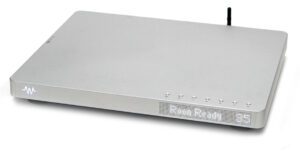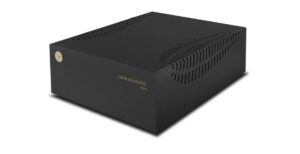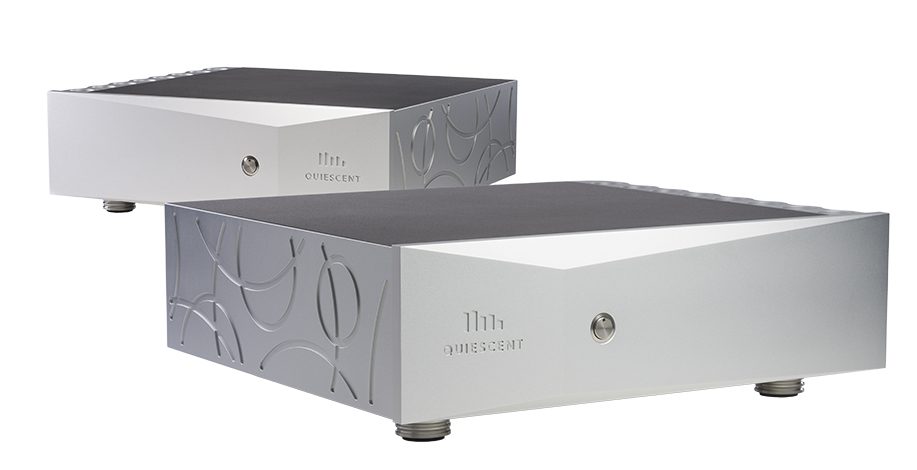
We might look at the T100MPA monoblock power amplifiers by Quiescent with initial puzzlement. The company’s stereo amplifier, the T100SPA, costs £20,000 and outputs 130 Watts RMS per channel into eight Ohms. The monoblocks cost twice as much but output the same 130 Watts per channel.
True, with the monoblocks we get two impeccably built and finished chassis rather than one. But come on….double the money – £40,000 rather than £20,000 – for the same power output? Actually there’s a lot more to this than first appearances suggest.
Jason Kennedy reviewed the T100SPA stereo amplifier here. He was smitten, struck in particular by how it revealed subtle recorded detail that he’d never heard before and how, despite its relatively modest output, the T100SPA had seemingly limitless headroom, able to drive a diverse mix of tricky loads including Bowers & Wilkins’ 802 D3s. Other ultra-quiet amplifiers exist of course, but their vendors focus on distortion mostly created during the amplification stages, seeking to suppress it through ultra-complex circuit designs and high levels of negative feedback. Quiescent’s approach is contrarian; minimalist gain stages with low feedback surrounded by a stockade of absorption for EMI and vibration-induced microphony. All of it is proprietary, and key elements are protected by patents.
Self-pollution
Quiescent is an audio manufacturer founded on military electronic systems know-how. Its insight is that vibration and EMI not only enters audio systems from the surrounding environment but that audio systems self-pollute; capacitors act as microphones in reverse, inductors ring, speakers are efficient EMI-emitters and so on. Our audio systems are not only by default transcribing and amplifying the wanted music signal mixed in with an unwanted burden of hash, but are themselves adding to the pollution. Dynamic agility, tonal purity, timing, dynamic expression and imaging all suffer. Because the pollution is systemic it is not mitigated by traditional measures. Screened interconnects, for example, simply act as efficient conduits for the pollution. A negative feedback circuit reads the incoming music signal with its burden of noise as legitimate and simply ensures that the same music mixed with noise is faithfully produced at the amplifier output.
Signal purity matters in audio, but it is really important in military electronics. Quiescent has taken technologies used in this setting and developed lossy matrixes and other passive measures specifically for deployment around audio systems. They are available as stand-alone modules for use with speaker cables, mains leads, system components and interconnects. Some have been reviewed in previous issues of this publication. The T100SPA, and now the T100MPAs, are the company’s first commercial foray into amplification and they make full use of the intellectual property, but deploying it internally rather than as external system add-ons.
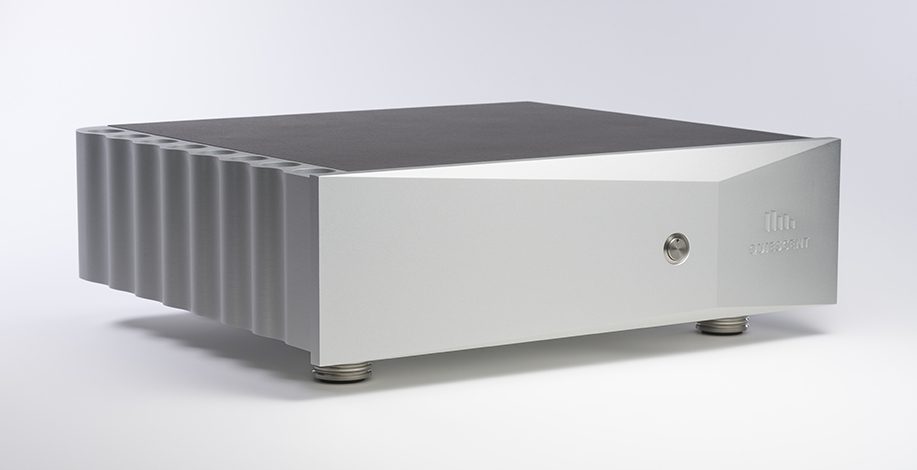
The stereo amplifier has Quiescent’s absorptive matrixes in its mains and signal inputs, and clamped to the 700VA peak toroidal power transformer, while the proprietary bridge rectification circuit and capacitor bank are each built directly onto their own absorptive matrixes. The signal amplification is a Class A/B DC-coupled current feedback design with ultra-short board tracks and two 250 Watt Exicon MOSFETs per channel. They are operated at a conservative 130 Watts for a gain of 26.5dB. Claimed bandwidth is 0-600 kHz, -3dB, and THD 0.03% at 24 Watts. The amplifier is biased for 1 Watt in Class A and has a noise floor, measured conventionally by FFT, of better than -120dB, and an input impedance of 10 kOhms. As Payne observes, it’s a world away from the multi-board, multi-transistor industry norm; not quite the proverbial straight wire with gain, but as close to it as Quiescent was prepared to go, this time around, in the pursuit of sonic truth.
The amplifier makes each channel of the output negotiate a further EMI and vibration-stripping matrix before it reaches the rear-panel speaker terminals. This kiss goodbye for the signal is bi-directional, mopping up any remaining pollution that might be created inside the amplifier, but also preventing vibration and EMI generated by the speakers from being passed back down the speaker cable to cause intermodulation in the output stage of the amplifier. Wiring between the functional blocks is implemented using solid core conductors (solid silver for the signal, silver-plated for power) in Teflon tubing with an EMI-absorptive outer sleeving.
For the monoblocks, the deletion of the second channel in each chassis frees up internal real-estate for the deployment of additional EMI and vibration absorption and also allows a re-arrangement of the internals. The MOSFETs, biased now for 2.5 Watts in Class A, are clamped directly to their own matrix to mop up the EMI and vibration created as they switch states during normal operation. The transformer is moved to a front corner, putting a potential noise generator as far from the sensitive inputs as possible. It also gets three absorbent matrixes, one on the primary and two on the secondary. In aggregate the monoblocks have three times the EMI and vibration mitigation of the stereo amplifier.
Are you lookin’ at me?
Physically the monoblocks are mirror images of each other with sculpted front panels, one offset to the left, the other to the right, each with an illuminated power button. The rear panels are similarly mirrored, the speaker terminals and RCA and XLR inputs offset so that the pair of amplifiers can be arranged to best suit longer or shorter existing cable lengths. Also on the rear panel, in addition to a regular IEC power socket, is a screw-down chassis grounding pillar, plus a single RCA signal ground terminal. Toggle switches allow input selection and the front panel indicator light to be turned on or off. A single lateral heatsink runs down the left side of one monoblock and the right side of the other one. Vertical tubes bored into billet aluminium have spiral grooves milled into their inside face to mitigate any potential for acoustic ringing. The non-heatsink side of the monoblocks are milled with acoustically disruptive patterns. The chassis lids are a non-metallic composite to avoid Faraday-cage effects. Each monoblock weighs 31 kg and stands on three substantial adjustable stainless steel feet.
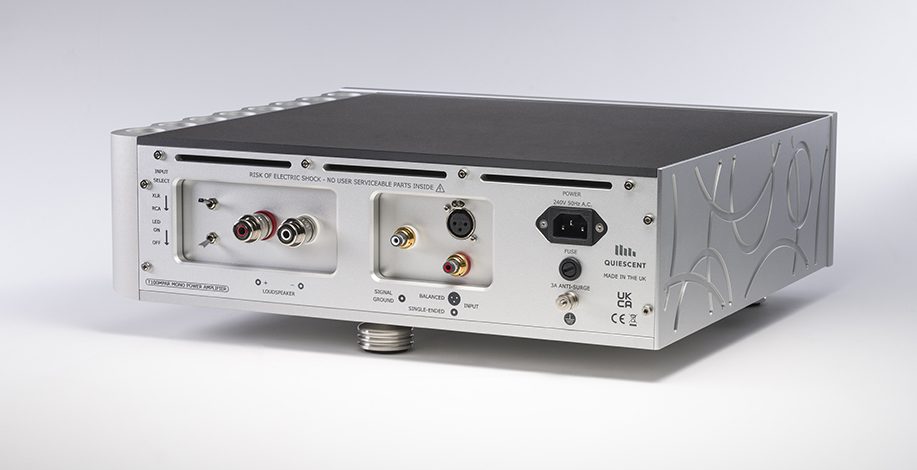
Did someone just murmur the word obsessive?
So, Quiescent, why not twice the power in the monoblocks? It comes down to the company’s perspective on what undermines the sonic performance of audio systems, and its supreme confidence in its anti-EMI and anti-microphony technology. As Payne puts it: “An ability to drive a constant 10 Amps into a 2 Ohm load is more than sufficient for pretty much any domestic speaker, so we went for increased sonic quality. The gains from more EMI and vibration absorption are far greater than those resulting from a doubling of power output.”
THD or not THD
Quiescent is not saying that power and THD doesn’t matter. What it is saying is that beyond a certain point the removal of EMI and vibration-induced microphony have a far more beneficial impact on sonic quality than chasing more Watts or further zeroes to the right of the decimal point. The interesting annoyance from an engineering standpoint is that while the presence of Quiescent’s quietening technology can be shown by FFT analysis, this conventional benchmarking fails to capture the scale of the sonic impact that the quietening has for listeners. A different measurement is required. Quiescent’s technical lead John Cheadle says the late Professor Gareth Humphries-Jones and a team at Bangor University pointed the way towards this over a decade ago with their work on measuring interconnects in the time domain. References to this work are still available on the Web.
A T100SPA stereo amplifier was used in the review system for four weeks before the monoblocks were delivered. The new arrivals were connected, as the stereo had been, to a pair of PMC MB2se speakers. The sources, a Jay’s Audio CDT3 MK3 and a Grimm Audio MU1 streamer, played through a Mola Mola Tambaqui DAC via an icOn 4PRO balanced passive line stage, also remained the same.
It was immediately – as in the first two bars of the first track – apparent that while the Quiescent stereo amplifier poses a profound sonic challenge to our understanding of what quiet sounds like, the monoblocks do the same, but even more so. Actually ‘more so’ doesn’t do the T100MPAs full justice. Many readers will be familiar with the overwhelming superiority of OLED over LCD when it comes to how displays reproduce blackness. With a true black background, OLED images seem to pop with a greater vibrancy, detail and naturalness. Compared to highly-rated alternative amplifiers the Quiescent monoblocks and stereo amplifier might be said to do a similar thing with sound.
The sound of silence
It’s a rare moment when we encounter amplification so completely competent in the delivery of all four musical pillars that it seems pointless, fatuous even, to offer the regular type of reviewing narrative, and thus it is with the T100MPAs. Dynamic expression, dynamic agility, tonality and timing are quite beyond reproach, and presented from out of the blackest background than it’s possible to imagine. There should be no surprise that the monoblocks should achieve an even greater separation between musical events than the stereo version, but the further depth of inky blackness provided by the monoblocks enables them to reveal even more of what’s buried in each recording. We hear top-of-the-class dynamic expression with serious but not over-cooked slam and weight, accompanied by life-like agility and rich texture. The monoblocks trace recordings with breath-taking speed and subjective accuracy, yet, and some might consider this counterintuitive, they sound relaxed, tension-free and natural.
The almost total absence of ringing intermodulation artefacts and HF hash around musical events was initially particularly de-stabilising. With the benefit of post-T100MPA hindsight, previously cherished benchmark amplifiers of several makes had to be mentally re-ordered having been exposed as exhibiting – some glaringly so – both faults. What was previously heard as ‘air’ and ‘presence’ around instruments and voices, and desirable tonal detail, was shown by the T100MPAs to be a corruptive add-on to the music signal. In other words, the Quiescent amplifiers don’t initially sound right, until we understand that what we’ve assumed all long that good audio should sound like is actually for the most part and to a greater or lesser extent polluted and just plain wrong.
The T100MPAs sounded overwhelmingly more dynamically expressive than an amplifier whose THD figures are quoted as 0.0003%, rendering the softest of string plucks on Billy McLaughlin’s The Archery of The Guitar as limpid, almost luminescent physical events, the subtle kinetic energy given to each pluck by McLaughlin’s finger-tips given natural expression by the Quiescent contrasting strongly with the dead-pan, matter-of-fact and un-engaging reading given by the alternative.
The T100MPAs were pitted against a second much-admired amplifier with a similar result. Playing the Avishai Cohen Trio’s album Gently Disturbed, Shai Maestro’s piano (yes, that’s a real name), turns out to be gorgeously well-recorded. Again, through the T100MPAs dynamic weight and expression were to the fore, and out of blackness the complex tonal texture of Maestro’s piano. Missing was a colouration previously assumed to be on the recording – a ringing intermodulation that placed a halo of noise around each key strike. Later on the same disk, upright bass, cymbals could be heard treated with the same respect for recorded actuality, the T100MPAs declining to editorialise but at the same time delivering levels of dynamic energy that much more convincingly supported the illusion of ‘live’.
The comparative absence of intermodulation and background noise hash, coupled with the strong dynamic agility achieved by the T100MPAs, enabled them to deal peerlessly with the fiercely complex material played by the Multiquarium Big Band on the album Remembering Jaco. There are points on the album so busy that it can all tend to fall apart and become a hazy sonic blur. The T100MPAs handled the material calmly, their speed and lack of intermodulation and hash allowing them to present the multiple layers and cross-rhythms with clarity, free of the normally heard smearing, but with the band’s irrepressible foot-tapping drive and energy convincingly presented.
Don’t touch me
It’s worth re-stating that Quiescent’s passive absorptive technology does not touch the music signal in any way. In other words, it is not filtering in the sense that we understand the term. What it does in the T100MPAs and the stereo amplifier is mitigate the vibration and EMI that would otherwise be created inside the amplifiers and go on to cause the unwanted sonic artefacts.
It follows therefore that the old mantra of rubbish in, rubbish out still applies. If the source is busily embedding unwanted noise within the music signal then while the T100MPAs or the stereo amplifier will not add to it, they cannot remove it. They are not get-out-of jail cards for poor upstream components, hence Quiescent’s range of stand-alone modules that work to remove vibration and EMI within sources, line stages, interconnects and so on.
Quiescent says the monoblocks, with an output per channel identical to that of the stereo amplifier at 130 Watts, also pull the same 480 Watts from the wall socket on maximum draw. And yet back-to-back listening showed them to be subjectively more powerful than the stereo. Go figure, as they say. True, they have the advantage of a dedicated power supply per channel, but unless Quiescent is playing fast and loose with its claims – and we are assured that it isn’t – the only other difference between the stereo amplifier and the monoblocks is simply that the latter have a lot more of the company’s quietening technology. There is therefore no other way to understand this than as confirmation that Quiescent is properly on to something very important. The company has secured protective patents for its intellectual property with very good reason.
What we have here is amplification that poses a direct challenge to some key aspects of established technical thinking, and at the same time a commercial challenge to some very high-flown alternatives indeed. That the T100MPAs can do so is down to Quiescent’s understanding – demonstrably unique in the audio industry – of the damage that vibration and EMI do, and the company’s dogged pursuit of technologies to mitigate that damage.
Quiescent’s amplifiers, first the T100SPA Stereo and now to an even greater extent the T100MPA monoblocks, are truly disruptive, game-changing even.
Technical specifications
- Type: Solid-state mono power amplifier
- Minimum Load Impedance: 2Ω
- Power Output: 130W RMS per channel into 8Ω, 200W RMS per channel into 4Ω
- Frequency Response: -3dB at 0.5Hz to 600KHz
- Slew Rate: 46V/µs
- Terminals: WBT nextgen™ Ag Silver conductor binding posts
- Input Impedance: 10KΩ
- Sockets: 2 × WBT nextgen™ Ag Silver phono or 2 × silver XLR (switchable)
- Chassis: M5 Binding post on rear panel
- Signal: RCA socket on rear panel
- Finish: Bead blasted natural or black anodised high grade aluminium and non metallic top
- Cooling: Passive
- Dimensions (H×W×D): 140 × 440 × 400mm
- Weight: 31Kg
- Power Input: 230V, 50Hz
- Price: £40,000 per pair
Manufacturer
Quiescent
By Kevin Fiske
More articles from this authorRead Next From Review
See all
PrimaLuna EVO 100 phono preamplifier
- Apr 22, 2024

Reiki Audio SuperSwitch Master Pro + Servant Pro
- Mar 27, 2024

Melco Audio N1-S38 music server
- Mar 27, 2024








